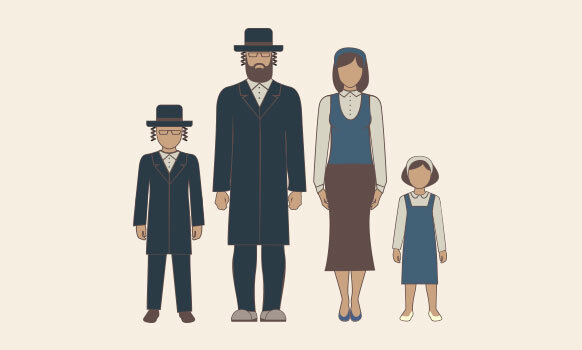Since 9-11, the media have — with good cause — lavished attention upon Islam in America.
There’s been less interest in the cultural and demographic challenges facing Judaism, long the nation’s second-largest religion behind Christianity. Jewish news coverage in the mainstream press tends to focus on Democratic Party politics, trends in anti-Semitism and attitudes toward Israel and the unending Mideast mess.
Those are important, of course, but what about Judaism as a living 21st Century religious faith? Here, as so often, the Pew Research Center steps up with its 248-page survey on “Jewish Americans in 2020″ (click here for the .pdf report).

The Guy proposes that this is the ideal moment for journalists to focus on the religion of Judaism, asking rabbis and lay synagogue leaders how Pew’s trends are playing out both nationally and with their particular audiences and locales.
At one time, Jewish federations conducted such community surveys. This one follows up Pew’s major survey in 2013 but direct comparisons with the 2000 numbers are iffy due to changed methodology.
As so often, Pew worked from an unusually large random sample of 4,718 Jewish adults who were interviewed between November 2019 and June 2020. To learn more about Pew’s revised methodology to cope with low “response rates” among those sampled — among factors that produced the embarrassingly wrong 2020 political polls — see this prior Guy Memo.
As writers dig into the numbers they’ll understand fears that unless things change “we are going to lose the illusion of there being a Jewish people.” So says “modern Orthodox” Rabbi Shmuly Yanklowitz, speaking with Forward.com (“Pew’s new study of American Jews reveals widening divides, worries over antisemitism”).
The bottom line: Across the board, the gap between Orthodox and non-Orthodox Jews is deepening. This looks very much like the gap between declining U.S. “mainline” and “liberal” Protestants over against conservative or “evangelical” believers, or the gap between traditional religious believers and the growing world of atheists, agnostics and the “religiously unaffiliated.”
Among Orthodox Jews, 23% have “not much” in common with Reform Jews — plus 26% who say “nothing at all.” Among Reform Jews, 39% have not much and 21% “nothing at all” in common with fellow Jews who are Orthodox.
Fears that Judaism might gradually shrink to irrelevance are allayed in the new data, which show a stable population. An estimated 5.8 million adults and 1.8 million children count as Jewish in some sense. Surprisingly, 8% of U.S. Jews are something other than white and non-Hispanics.
Still, there’s ongoing cause for angst about the future when 2% of married Orthodox Jews have a non-Jewish spouse while that number reaches 47% among the non-Orthodox. Among intermarried Jews with children under age 18, only 28% are raising them in the Jewish religion.
Here’s a sampling of other findings to run past your sources.
* As with the growing religious “nones” in the general U.S. population, 27% of Jewish adults do not identify with the religion of Judaism, and four out of 10 among those under age 30.
* Younger Jews are going more Orthodox, claiming 17% of those under age 30 compared with a mere 3% of Jews 65 or older.
* As Judaism’s Conservative or middle-road branch becomes less distinct, will it unite someday with the more liberal Reform branch? Among all Jewish Americans, 37% identify with Reform, 17% as Conservative, and 9% Orthodox, basically the same as in 2013.
* The Orthodox stand out with 86% saying religion is “very important” in their lives, exceeding that view among Black Protestants (78%) and white evangelicals (76%).
* Among Jews as a whole, 71% are Democrats or “lean” Democratic while 75% of the Orthodox identify or “lean” Republican.
There’s lots more here to discuss.
Sourcing: For perspective with stories of this type, The Guy especially recommends Jack Wertheimer, a historian of modern American Jewry, at Jewish Theological Seminary (jawertheimer@jtsa.edu and 212-678-8869).
– – – – –
Added notes for the religion-news datebook:
America’s two largest Christian bodies compete head to head for attention next month. The Southern Baptist Convention’s annual get-together occurs June 15-16 and the U.S. Conference of Catholic Bishops meets June 16-18. Which will warrant travel expenses and get the news play?
One could argue that neither event is all that important. It appears to be a given that whether President Joe Biden is denied Communion due to his pro-choice abortion stance is decided by each local bishop (click here for recent tmatt “On Religion” column on this topic), not the national conference itself.
Meanwhile, Southern Baptist conservatives upset about women pastors and preachers have no control over what self-governing congregations do.
Nonetheless, The Guy insists that airing of those and other matters at the two major confabs will be highly newsworthy and indicate where these influential religious bodies are heading.
Also upcoming there’s the Promise Keepers men-only conference July 16-17. What ever happened to this once-prominent evangelical organization played an important role building bridges between Black and White evangelicals and Pentecostal believers? Will it be able to fill (or fill as much as COVID allows) the AT&T Stadium in Arlington, Texas, as it did at major venues all over the nation not so long ago?










